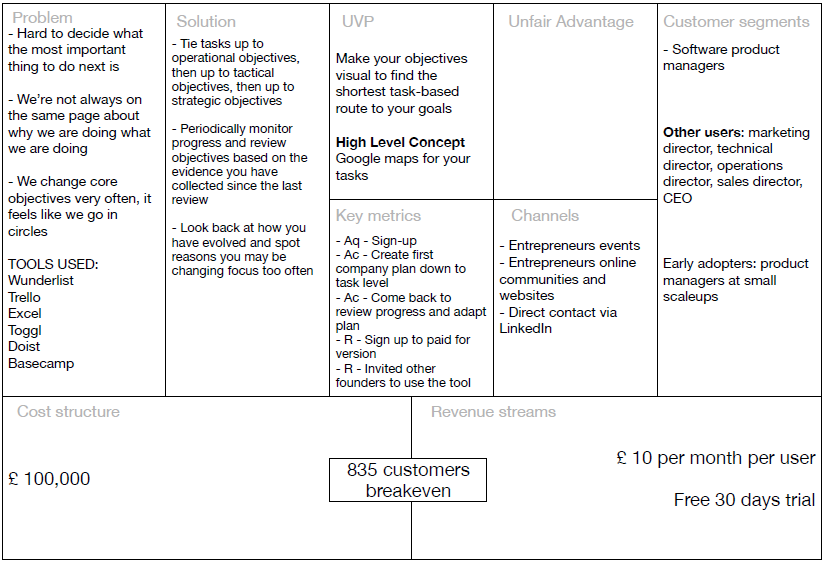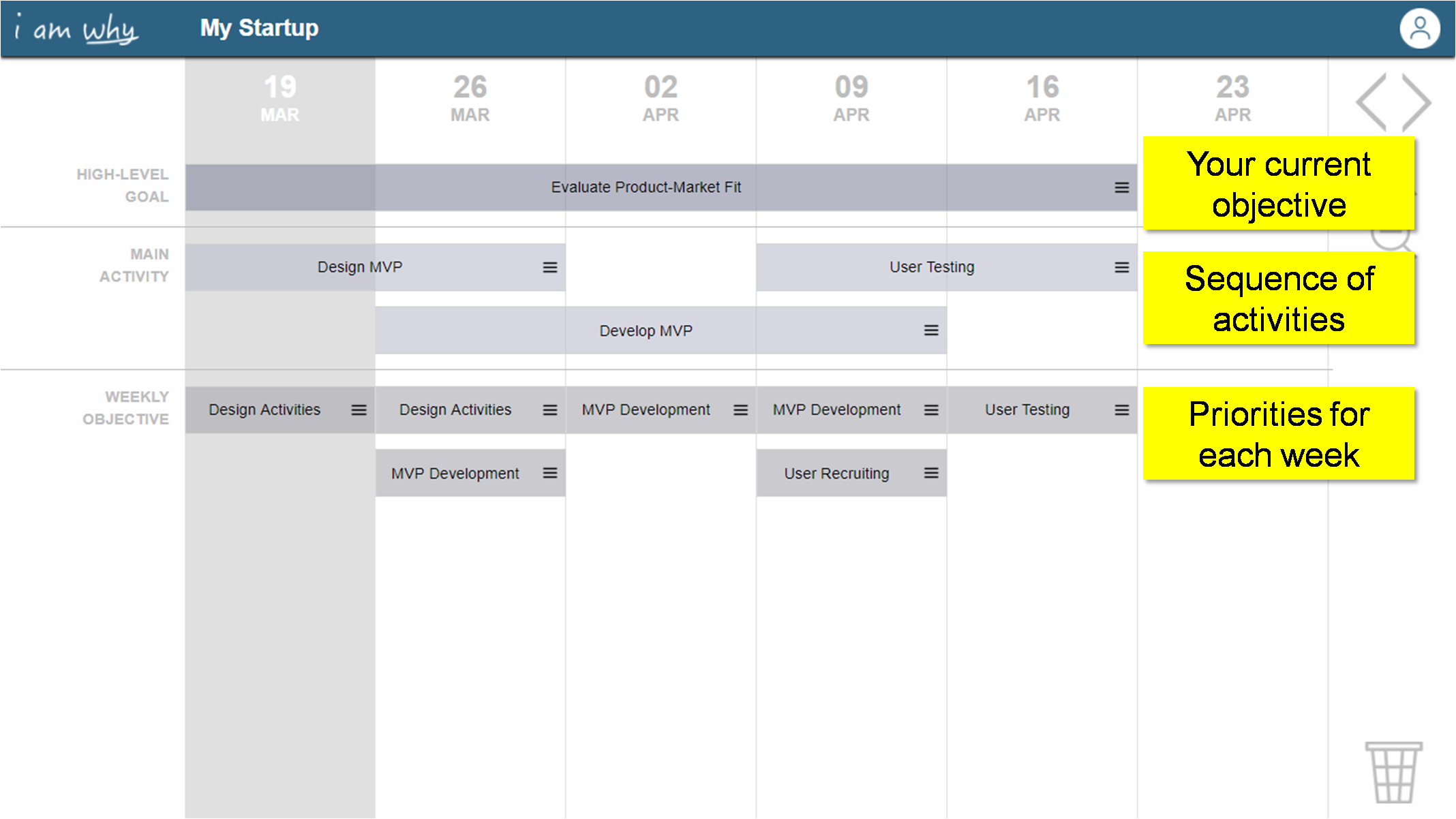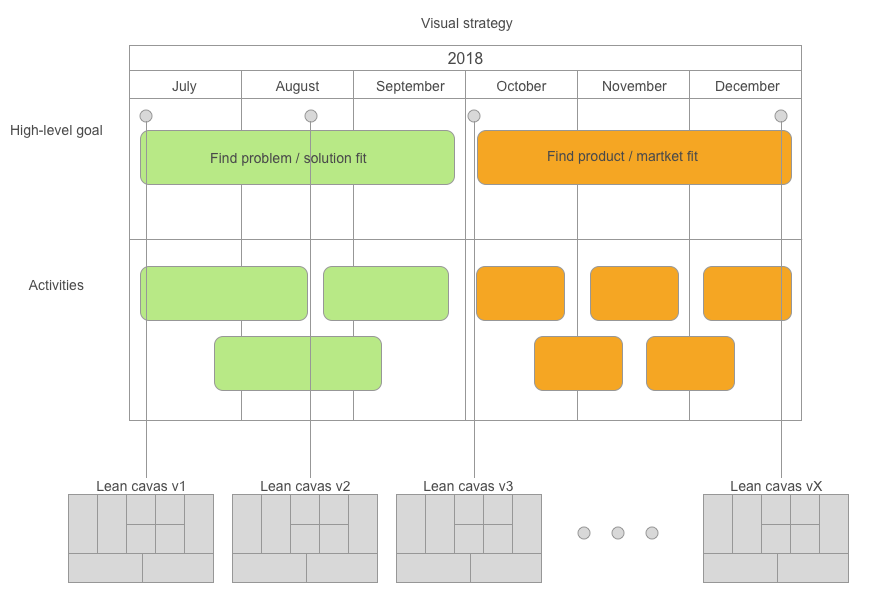
How to get things done fast in a Startup with Lean Strategic Planning
Francesco Marcatto13 Apr 18
More than anyone else in business, startup founders need to get things done fast. Big companies have a lot of resources but are slow and risk-averse, it could take months for them to make even some trivial decisions, and if they fail, they fail big.
Startups instead can move very fast. We all know that a bunch of whiz-kids could build a new app, get a landing page up and gain some traffic in some weeks. But being just fast deployers isn’t the main thing. The real advantage of startups is the possibility of being fast learners and adapters.
Lean Startups do it better
The life of a startup is filled with uncertainty. You don’t know if you’re trying to solve the right problem, if your solution is a good solution, if people will actually pay for your product, what’s the best way to reach potential customers, and so on. When you start, you know very little, but there are smart ways to reduce all this uncertainty as fast and as economically as possible.
According to the Lean Startup framework, the fundamental activity of a startup is to continuously experiment, gain new knowledge and react to it fast. You have an idea, test it on the market, you keep what worked and change the rest, gain more feedback and iterate this build-measure-learn loop until you have something great in your hands! (Admittedly that won’t happen for all of us, so sometimes, it will be time to find another job or a new project. But at least you won’t waste too long on something that is doomed anyhow).
This is, in a nutshell, the core principle of the Lean Startup framework.
What is Lean Strategic Planning?
Build-Measure-Learn is easy to remember, but this alone won’t guide you towards success.
As I wrote in another set of articles, you need a strategy and a plan to make your strategy real. If you are running lean, you need a plan that will give you direction, help you stay on track, and support you and your team in getting the right things done fast. You need Lean Strategic Planning.
Lean strategic planning means that you have a strategic plan which will guide and focus your team’s actions, but it’s not carved into stone. In an uncertainty-filled and constantly changing environment, there are enormous benefits in being ready to adapt to new information. Therefore, there’s no point in spending a huge amount of time in preparing an over-detailed strategic plan for the next 24 months, and then follow it blindly because we spent so much doing it and we think it’s brilliant.
The lean strategic plan, instead, is a living document which will grow and change as you experiment and get new information. You don’t need long-term forecasts, so it’s better to start by focusing on a narrow time frame, a couple of months or even just some weeks. Your plan should contain your starting assumptions and hypotheses, your goals and the activities for reaching them. And don’t worry if you feel it’s not perfect, you’ll adjust it as more information will come.
To recap, lean strategic planning should be:
- Short, plan ahead for just a couple of months, everything beyond this time frame will very likely be just a wild guess;
- Nimble, your plan must be flexible and open to change and adjustments;
- Focused, it should contain all the information you need to start working on the build-measure-learn loop.
FAST Tools for Lean Strategic Planning
Defining and putting down your strategy with standard tools can take forever: long meetings, hundred-pages long business plans, PowerPoint presentations, etc. For lean strategic planning, instead, you need simpler and faster tools. You must be able to play with your strategy and update it anytime you need. The FAST principle is an acronym that sums up the features of a suitable tool for lean strategic planning. According to this principle, good tools for lean strategic planning must be:
- Fast, you should be able to outline it in half an hour or less, and updating and adjusting it should be an extremely easy and painless process;
- Actionable, your plan should have practical value and guide your team’s actions;
- Simple, all your team members should be able to understand it all just by looking at it;
- Trackable, it should help you in keeping track of your progress and of the results of your experiments.
Specifically, there are two tools which we use constantly at Mindiply for planning our strategies and guiding our activities: the Lean Canvas and a Visual Planning tool called I Am Why.
Lean Canvas
If you ever had the ‘pleasure’ of developing a traditional business plan, you know the pain. Business plans take forever to be developed, they’re extremely long, hard to understand, seldom updated, and, most importantly, almost never read. Essentially, a standard business plan lacks all the features of the FAST principle.
Lean startups can instead create a Lean Canvas, a single-page business plan template that helps you deconstruct your idea into its key assumptions. Using the nine fields of the lean canvas, you can have an overall view of your business, which includes all its key elements: what is the problem you are trying to solve, who has this problem, how will you solve it, and how to develop a sustainable business.
In about twenty minutes you can have your first lean business plan ready, but remember that it's made to be updated and changed frequently. At the beginning, most of the content of your lean canvas will be hypothetical, but it will evolve into a more mature and precise one as you carry on experimenting and collecting more information during each stage of the development of your startup. At the end of the process, when you'll have obtained a working business model, your lean business canvas will be very useful for effectively communicating your business to investors and potential customers.
The Lean Canvas has been developed by Ash Maurya, the author of Running Lean, and can be found here.

Visual Planning
The Lean Canvas is a great tool for putting down your hypotheses and your key assumptions. It helps you and your team in answering questions such as which problems are we going to solve, how should be our solution, who are our customers and how to reach them, and so on.
It doesn’t help, however, in answering a different set of question: What shall we work on during this week? What are our priorities now? Are we on the right track or it’s time to adjust our strategy?
A very common problem, is that we are always busy doing a lot of things, but we seldom do what’s really important for moving our business forward. Indeed, during every working day there are many things we could do, but we should focus on doing the things that move the needle only. All the rest should be done when there is time.
Learning to prioritise is difficult, and it’s more complicated in a team setting: individuals have different ideas about what is the most important thing to work on, and this misalignment can lead to a waste of time and resources.
Visual planning tools can be greatly useful for coordinating your team’s day to day work with your overall strategy. On a timeline you can see your roadmap with your current main objective and all the activities that should bring you closer to the desired goal.
At a glance, you have basically everything you need to know for prioritising your activities: what to do, the expected deadline, and why this thing is so important. Much better than the usual laundry list of things to do provided by traditional task management tools.
Moreover, in I Am Why, Mindiply’s tools for visual planning, you can create a strategic plan with just a bunch of clicks, and with the drag and drop interface, changing and updating your plan is incredibly easy.

At Mindiply, we are using a combination of both tools. Our hypotheses and assumptions are documented in a Lean Canvas, and we manage and keep track of our activities in I Am Why. Both tools are mostly visual, concise and straight to the point. More than anything, they complement each other and work great for getting the right things done fast!

We always looking for tools which will help startups and new entrepreneurs in working better. Do you know other tools for lean strategic planning that follow the FAST principle? Let us know at hello@midiply.com or via our social media channels!








